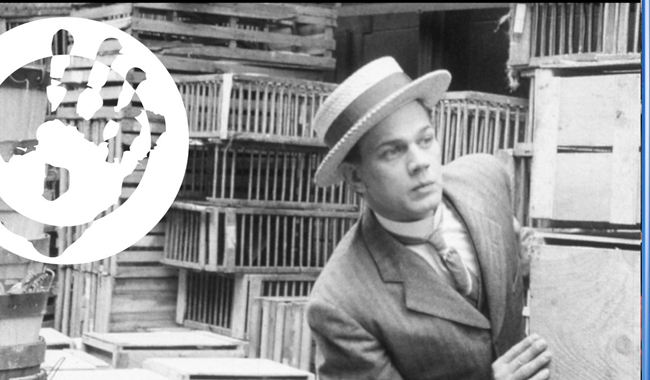
Too Much Johnson Review
 A man (Joseph Cotton) woos and seduces a married woman (Arlene Francis) but is caught by her husband (Edgar Barrier). He chases the man out the window and across the rooftops of Manhattan and does so for the entirety of the picture. Too Much Johnson had been a play written in 1894 by William Gilette. To say that this is a slapstick farce would be an understatement. The short film, running in at a mere 67 minutes appears to have no artistic merit. That the film was made by Orson Welles is shocking; that it was made by Orson Welles who would go in the next 3 years to complete and release the critically acclaimed Citizen Kane, often cited as the greatest film ever made is even more shocking. Made by Welles’ Mercury Theatre production company, Too Much Johnson was filmed al fresco on the roofs of Manhattan with some at times dangerous looking stunts that would challenge the golden age of silent comedy but lacks much of the merit of these old films.
A man (Joseph Cotton) woos and seduces a married woman (Arlene Francis) but is caught by her husband (Edgar Barrier). He chases the man out the window and across the rooftops of Manhattan and does so for the entirety of the picture. Too Much Johnson had been a play written in 1894 by William Gilette. To say that this is a slapstick farce would be an understatement. The short film, running in at a mere 67 minutes appears to have no artistic merit. That the film was made by Orson Welles is shocking; that it was made by Orson Welles who would go in the next 3 years to complete and release the critically acclaimed Citizen Kane, often cited as the greatest film ever made is even more shocking. Made by Welles’ Mercury Theatre production company, Too Much Johnson was filmed al fresco on the roofs of Manhattan with some at times dangerous looking stunts that would challenge the golden age of silent comedy but lacks much of the merit of these old films.
It is shot in an almost unedited form as a complete silent comedy replete with tinkling Joanna and speeded up hand cranked filming. The film was originally intended to be a short at 40 minutes and could certainly do with a good deal of trimming down, but even at 40 minutes would be heavy going. The best Mack Sennet comedies were two reelers (approximately 22 minutes at 24fps) and were often tightly edited to maximise the fun action and at their best the sheer inventiveness of the stunts and slapstick. These concepts are wrung dry here.
Why this film was made is something of a mystery, but what is equally mysterious is why it was never in a complete state. Looking at the cast alone is interesting: handsome Joseph Cotton is the chased man – he would later go on to star as the investigative journalist in Citizen Kane as well as appearing as the man searching for his old friend Harry Lime (Welles) in Carol Reed’s The Third Man (1949), but here appears in his first film. Also playing one of the Keystone-like cops, as well as Welles, is John Houseman, who co-wrote this and was Welles partner for the Mercury Theatre Company. Elsewhere comedienne Judy Holliday appears as an extra while Arlene Francis who plays the lover would later find fame in her 25 year stint on the popular TV game show, ‘What’s My Line?’. Too Much Johnson was considered lost for many years, believed to have been burnt in a fire at Welles’ house in 1971 but appeared in a rough state in Italy in 2008 and was later restored to the state we see on the disc.
Released along with two other rare Orson Welles films, Too Much Johnson is released on the Mr Bongo label, who pride themselves on releasing minor or lesser known classics but sadly like other films released on the label has no extras. It would be fair to say that Too Much Johnson is for Orson Welles compleists only.
Chris Hick
